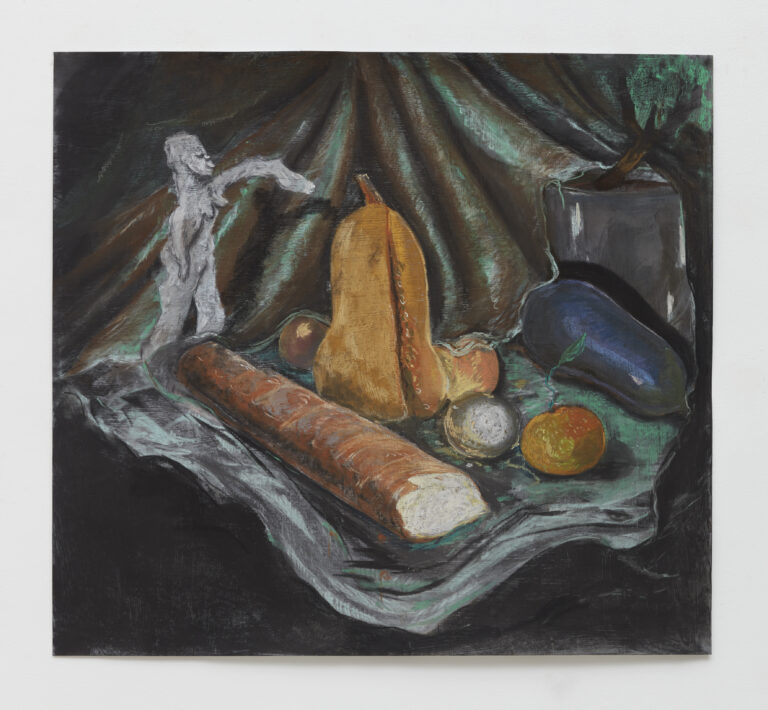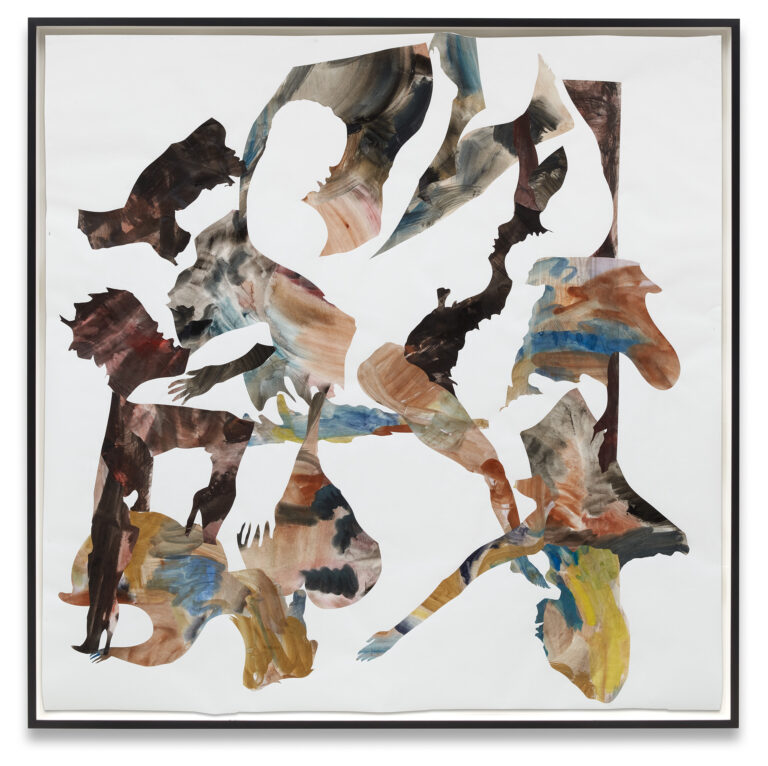Kara Walker
Kara Elizabeth Walker presents Dispatches from A— and the Museum of Half-remembered Histories
14 NOv 2025 until 4 APR 2026
Opening – 13 NOV 2025, 6-8 pm

Kara Walker
The Mountaintop, 2025
Watercolor and sumi-e ink on cut paper on paper
199.4 x 331.5 cm | 78 1/2 x 130 1/2 inches
© Kara Walker
Courtesy Sprüth Magers
Photo: Jason Wyche
Kara Walker’s œuvre scrutinises themes of race, gender, sexuality and violence, showcasing a profound exploration of societal complexities and positioning her as a preeminent figure among contemporary American artists. At Sprüth Magers, Berlin, Walker debuts all-new cutout collages in vibrant ink and watercolour. Presented on a grand scale akin to history paintings, these works build upon her iconic monochromatic silhouettes by harnessing the power of formal composition, texture and colour. The show is completed by new pastels that reimagine traditional genres and several arresting watercolour drawings.
For her new body of work, Walker takes inspiration from an 1870s illustrated Popular History of the United States to explore how the emergence of history is negotiated—one that continues to undergird the fraught realities of the artist’s home country. By examining this post-Civil War source, she interrogates the very mechanisms through which American identity has been constructed and mythologised. She employs colourful cut-paper silhouettes, skilfully blending loose, expressive washes of colour with sharply delineated forms to craft scenes that depict America’s violent historic and recent past, prompting critical reflection on their impact on contemporary realities. In artworks such as Tituba’s Handmaidens (2025), she commandeers historic imagery and art history—drawing on references from the Salem witch trials as well as works by John Singer Sargent and Diego Velázquez—and transforms these elements into incisive commentary that critiques prevailing narratives born from a pivotal moment when the nation’s foundational contradictions between freedom and oppression were actively being rewritten and whitewashed for popular consumption.

Kara Walker
Vanitas #3, 2025
Pastel on paper
99.1 x 108 cm | 39 x 42 1/2 inches
© Kara Walker
Courtesy Sprüth Magers
Photo: Jason Wyche

Kara Walker
Go Blonde or Go Home!, 2025
Watercolor and sumi-e ink on cut paper on paper
200.7 x 198.1 cm | 79 x 78 inches
© Kara Walker
Courtesy Sprüth Magers
Photo: Jason Wyche
In Liberation (after Ben Shahn) (2025), one of the large-scale collages on display, Walker reinterprets Ben Shahn’s 1945 scene of children playing among war rubble. While Shahn’s image balances despair with hope through the resilience of childhood play, Walker’s iteration strips away any semblance of innocence. In place of swinging children, she substitutes lifeless figures hanging from poles like flags in the wind—a stark imagery that symbolises the lives claimed in the name of war while also evoking the brutal public lynchings used to terrorise and control Black people, particularly in the South. In the foreground, a child plays hoop and stick, oblivious to the horror. Walker’s version is exponentially darker than Shahn’s, revealing how trauma becomes an inescapable backdrop to childhood, and suggesting that violence becomes normalised and passed down as inherited wounds to successive generations.
The erosion of democracy in real time permeates many of the exhibition’s artworks. The monumental cut-paper diptych Inaugural Fantasia (2025) presents a visual maelstrom of entangled naked bodies, some of which resemble political figures. The work functions as a critique of the fetishisation of political and military power, suggesting an almost sexual obsession with authority and dominance over feminised bodies that accompanies democratic decline. Walker often juxtaposes beauty with brutality, intimacy and exploitation, as seen in Cypher of the Old Republick and Cypher for the New Republick (both 2025). In both, the arrangement of body parts—heads, legs and arms—form loosely circular compositions. By referencing Philip Guston’s hooded Klan figures, and with titles referring to an old and a new state, they highlight the continuing cycle of violence. Together, the works underscore how power structures infiltrate personal lives and expose how authority has always operated through the violation of bodies, particularly under slavery’s enduring shadow.
The exhibition includes pastels on paper that reimagine vanitas still lifes through a contemporary lens. Vanitas #7 (2025) presents a wicker basket brimming with chard, radishes and asparagus, interspersed with severed feet, a hand and two heads among the root vegetables. Walker deliberately subverts the colonial luxury displayed in the traditional vanitas of the Dutch Golden Age and Spanish bodegones, confronting viewers with the cost of Western prosperity to Black life, while pointedly suggesting that those who have borne this exploitation need no reminder of death—it has been a pervasive presence. The autumnal abundance of these works also references American Thanksgiving and its incomplete and inaccurate national narrative, with the exhibition holiday timing amplifying this critical connection. The tale of Pilgrims and Native Americans coming together to feast and give thanks became popular in the late nineteenth century, allowing Americans to embrace a bloodless version of colonialism, which sidestepped the darker realities of slavery and ruthless westward expansion.

Kara Walker
Cypher for the New Republick, 2025
Watercolor and sumi-e ink on cut paper on paper
199.4 x 192.1 cm | 78 1/2 x 75 5/8 inches
© Kara Walker
Courtesy Sprüth Magers
Photo: Jason Wyche

Kara Walker
Top of Heap, 2025
Watercolor, gofun and ink on paper
76.8 x 56.5 cm | 30 1/4 x 22 1/4 inches
© Kara Walker
Courtesy Sprüth Magers
Photo: Jason Wyche
In an era where, as Walker observes, “Fantasy rules our world now. Conjecture, myth, storytelling, tall tales, hearsay, heresies, nobody to be believed and repercussions galore,” her art serves as both scalpel and mirror, dissecting the myths that sustain American violence while compelling viewers to confront their own implication in the construction of such narratives. By creating what can be described as a sort of eccentric history museum, Walker positions herself as a surreptitious instigator who appropriates the visual languages that have long legitimised Western culture—the vast scale of history painting and the authority of museum display. Through her masterful use of historical imagery and unflinching examination of power, she demonstrates that in times of widespread deception, the artist’s most vital role may be to make visible what others would render invisible, and to tell the truths that fantasy seeks to obscure.
Kara Walker (*1969, Stockton, CA) lives and works in New York. Selected solo exhibitions include Fundación PROA, Buenos Aires (2025), National Gallery of Australia, Canberra (2023), De Pont Museum, Tilburg, The Netherlands (2022), Schirn Kunsthalle, Frankfurt, Kunstmuseum Basel (both 2021), Turbine Hall, Tate Modern, London (2019), Domino Sugar Refinery, New York (2014), Camden Arts Centre, London, Art Institute of Chicago (both 2013), Center for Contemporary Art Ujazdowski Castle, Warsaw (2011), Hammer Museum, Los Angeles and Modern Art Museum Fort Worth (both 2008), Walker Art Center, Minneapolis, Whitney Museum, New York (both 2007) and The Metropolitan Museum of Art, New York (2006). Major international group exhibitions include Prospect.4, New Orleans (2017), 11th Havana Biennial (2012), 52nd Venice Biennale (2007) and Whitney Biennial, New York (1997).
Walker transformed a historical Confederate statue into a radically new sculpture for the group exhibition Monuments—co-organized by The Museum of Contemporary Art and The Brick, Los Angeles, running through April 12, 2026. Her major site-specific commission at the San Francisco Museum of Modern Art is on view until May 2026.
